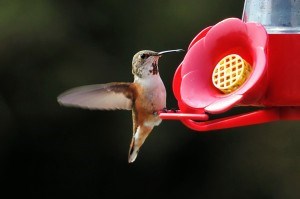
There’s a turf war going on in our neighbourhood, and someone is going to get hurt. They usually do.
Like small metallic orange bombs dropping in j-shaped streaks from the sky, the rufous hummingbirds have returned, letting loose their Tie Fighter-esque battle cry as they clash over territories with all the hormone-fuelled violence I’ve come to expect from these small but mighty hyper birds.
If you think I’m being melodramatic, then you’ve never seen one of these little hummers drive another into the ground and subsequently to its death. While it is often enough for them to simply chase one another away, battle injuries are not uncommon.
To have even half a chance at surviving these high-speed chases, rufous hummingbirds must be able to negotiate their environment with split-second precision, and most of the time, they do. It is well known they have exceptional spatial memory—used to record information about their environment, and where objects are around them. This matrix-like appreciation of space-time allows them not only to avoid objects, but also to pluck insects from the air at incredibly high speeds.
For males, all this zipping around and harassing others is ultimately about getting themselves some girls. They have to put on a good show, because they never know when a female might swing by to check them out. When a female enters their territory, so begins the J-shaped courting dives to win her over.
If the male plays his cards right, the female will show interest by perching, at which point the males really turn on the charm by switching to low, horizontal figure-eight flight patterns. If she sticks around after that, it’s time for a little bird nookie.
Not much is known about the act of hummingbird mating, but I’m guessing it’s fast. Considering the fact that their wings beat up to 62 times a second, one might expect the same rapid-fire physics to apply elsewhere. Males are polygynous, which means their only function is to breed with females. As soon as all the females are bred, the males blow these pine stands and start the long journey south to their wintering grounds in Mexico. In total, hummers will travel over 6,300 kms in a migration cycle, though many will be lost along the way.
Meanwhile, the females stay behind to pop out some white, jelly bean-sized eggs in a nest not much wider than an egg cup. The nests are tiny works of art, made of beautifully crafted lichen and needle installations well-hidden in the evergreens. Here, the chicks will be nurtured for a short 18 to 21 days, before they are expected to fatten-up, learn to fly, and prepare for the long journey to join their dads in the wintering grounds.
Migration is a dangerous business. Sadly, most hummingbirds die their first year, but when they’ve survived a full annual cycle, their life expectancy goes up dramatically. The record age of a banded rufous hummingbird is eight years and one month.
By the time the orange bombers return to the Rockies, most of last year’s young will be all fired up and ready to join their elders in the fight for territories, thus kicking off another chapter in the tumultuous, high-stakes Rocky Mountain turf war.
Who will live? Who will die? Who will get all the ladies?
Stay tuned to a backyard near you.
Niki Wilson
Special to the Fitzhugh
